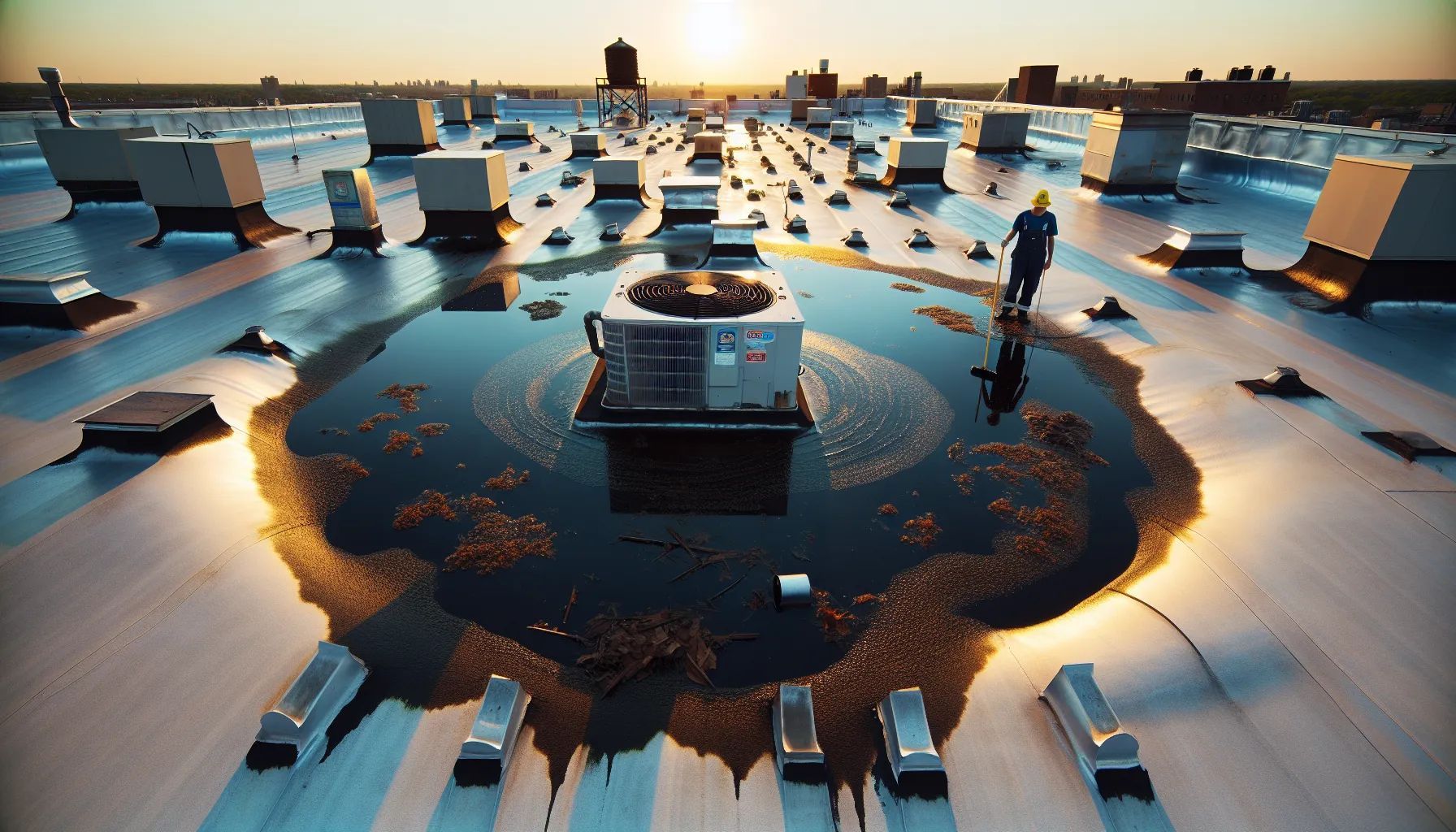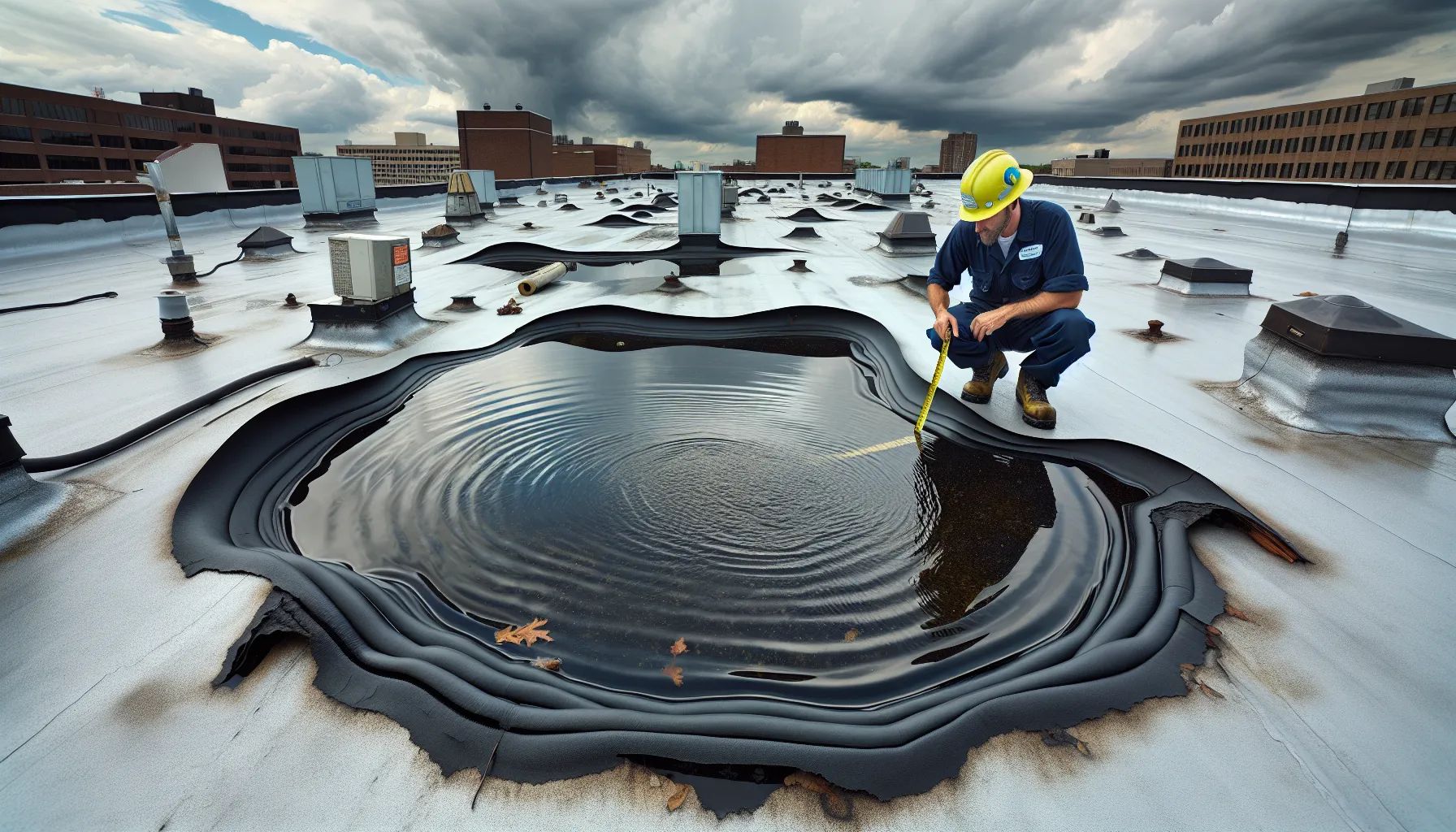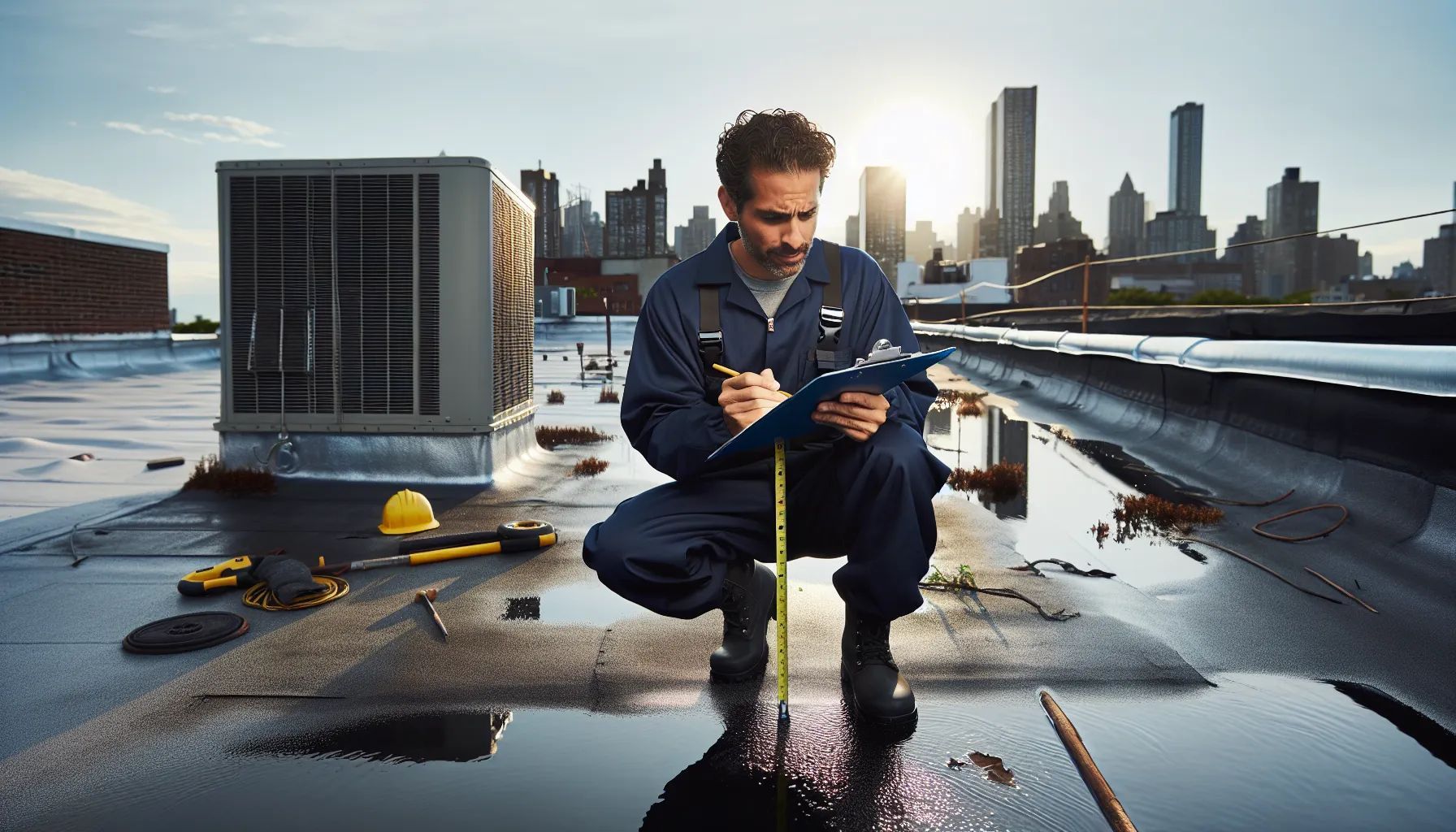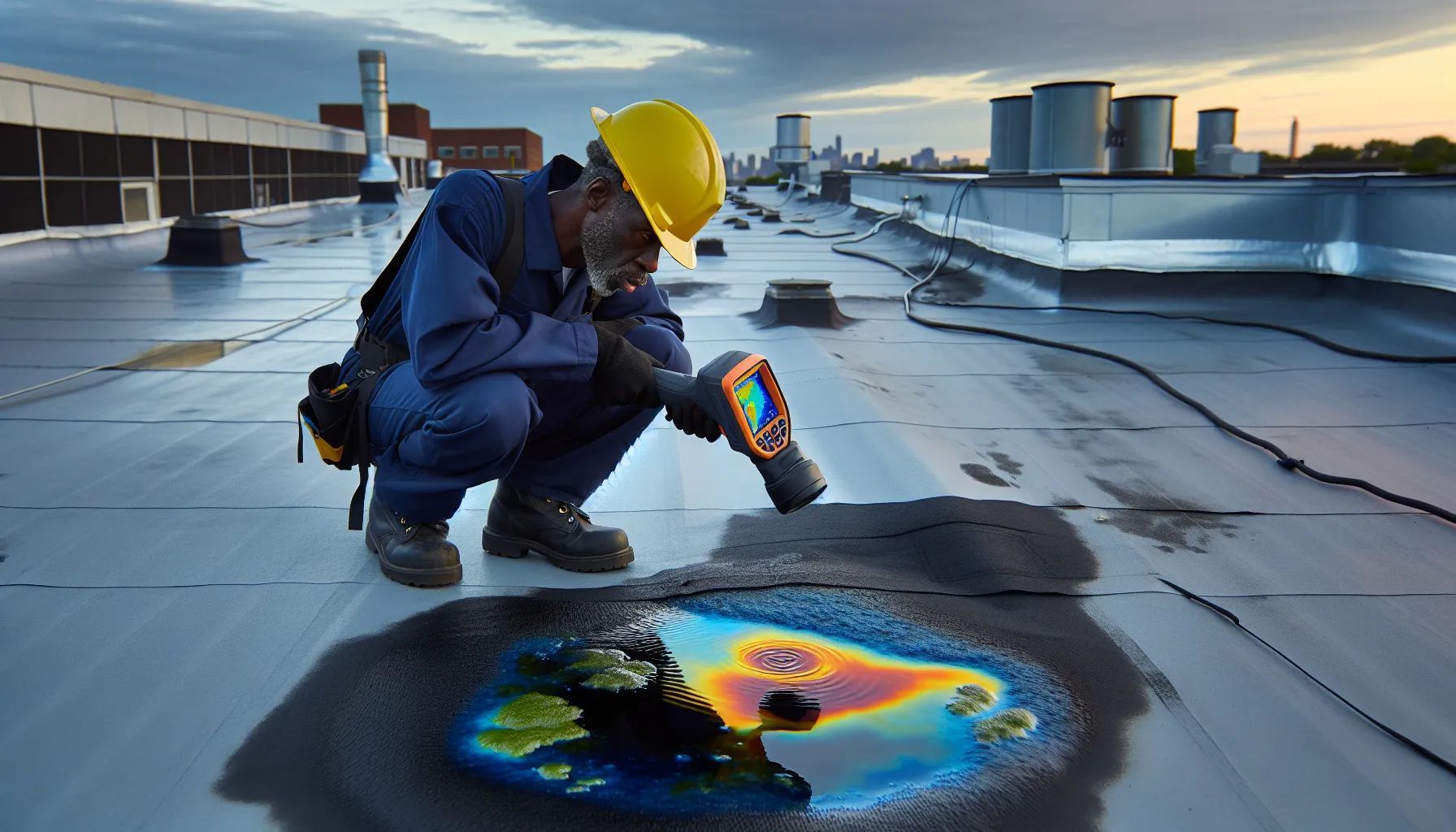Understanding Roof Ponding And Its Impact On Your Building

Roof ponding poses a serious threat to commercial and residential buildings alike. When water collects and remains on your roof for 48 hours or longer, it sets off a chain reaction of deterioration that can compromise your entire structure. We've seen firsthand how seemingly harmless puddles transform into costly disasters, from catastrophic leaks to complete structural failure. But here's what most property owners don't realize: the damage starts long before you notice any problems inside your building.
What Is Roof Ponding?

Roof ponding happens when water pools on your roof surface and stays there for more than 48 hours after the last rainfall. We typically see this problem on flat roofs and low-slope commercial buildings where water can't drain properly.
Think of it this way: your roof should act like a shallow ramp, guiding water toward drains or edges. When that doesn't happen, you get standing water. And standing water on a roof is about as welcome as a leak in your basement.
The 48-hour mark isn't arbitrary. That's the industry standard for determining when pooled water becomes problematic. Within this timeframe, water starts penetrating protective membranes, creating conditions for accelerated wear and structural damage.
We measure ponding severity by both the depth and coverage area. Even shallow pools covering large sections can cause significant problems. A quarter-inch of water might not sound threatening, but spread across hundreds of square feet, it adds thousands of pounds of weight your roof wasn't designed to handle.
Common Causes Of Roof Ponding

Understanding why water pools on roofs helps us prevent future problems. We've identified three primary culprits that account for most ponding situations.
Structural Deflection And Sagging
Roof decks naturally flex under weight, but excessive deflection creates permanent low spots. We often find this problem in buildings where the distance between structural supports exceeds design specifications. The roof deck bows downward, forming a bowl shape that traps water.
Equipment placement plays a bigger role than most people think. HVAC units, solar panels, and other rooftop installations add concentrated weight. Without proper reinforcement, these loads cause localized sagging. We've inspected roofs where a single air conditioning unit created a depression deep enough to hold several inches of water.
Age compounds deflection issues. Materials lose strength over time, and what started as minor sagging becomes pronounced dipping. Building settling also contributes, as foundations shift, roof planes change, disrupting original drainage patterns.
Inadequate Drainage Systems
Proper drainage requires more than just installing drains. The entire roof must guide water toward those exit points. Industry standards call for a minimum quarter-inch slope per foot, but we frequently encounter roofs with virtually no pitch.
Drain placement matters as much as quantity. We see buildings with adequate drain numbers but poor positioning. Drains clustered in one area leave other sections vulnerable to pooling. The drainage system must account for the roof's entire surface area and anticipated water volume.
Missing overflow drains create dangerous situations. Primary drains handle normal rainfall, but heavy storms overwhelm them. Without secondary drainage paths, water accumulates rapidly. We've witnessed roofs holding thousands of gallons because backup systems weren't installed or maintained.
Debris Accumulation And Clogged Drains
Leaves and dirt seem harmless, but they're drainage killers. Debris forms dams around drains, blocking water flow even when the drain itself remains clear. We regularly find drains surrounded by organic matter creating perfect ponding conditions.
Biological growth accelerates clogging. Algae and moss thrive in moist environments, expanding into drain openings. These organisms trap additional debris, forming dense mats that completely stop drainage.
Neglected maintenance turns minor debris into major blockages. What starts as a few leaves becomes compacted material that requires professional removal. We've extracted solidified masses from drains that hadn't been cleaned in years, some weighing over 50 pounds.
Signs And Detection Methods

Early detection prevents catastrophic damage. We use both visual observation and technical analysis to identify ponding problems before they escalate.
Visual Indicators Of Ponding Water
Obvious puddles tell only part of the story. We look for subtle signs that reveal chronic ponding issues. Discoloration patterns show where water repeatedly collects, these areas appear darker or stained compared to surrounding surfaces.
Algae and plant growth signal persistent moisture. When we spot vegetation on a roof, we know water lingers there regularly. These biological indicators often appear before visible pooling becomes apparent.
Membrane degradation provides clear evidence. Bubbling, cracking, and peeling near low points indicate water damage. The roofing material literally breaks down from prolonged exposure, losing its protective properties.
Dirt rings mark previous water boundaries. After ponding water evaporates, it leaves distinctive circles of accumulated sediment. These rings map out problem areas even during dry periods.
Professional Inspection Techniques
We employ specialized tools beyond visual assessment. Electronic moisture meters detect water trapped beneath membranes, damage invisible to the naked eye. These readings reveal saturation patterns and help us trace water migration paths.
Slope analysis uses precise leveling instruments. We measure roof pitch across multiple points, identifying areas below minimum drainage requirements. This data creates a topographical map showing exactly where water will collect.
Core sampling provides definitive answers about underlying damage. We extract small sections to examine all roof layers. These samples reveal whether water has penetrated insulation or reached the deck structure.
Infrared thermography spots temperature variations caused by trapped moisture. Wet areas retain heat differently than dry sections, appearing as distinct patterns on thermal images. This non-invasive method covers large areas quickly.
Risks And Consequences Of Untreated Ponding
Ignoring ponding water triggers a cascade of increasingly severe problems. We've seen minor pooling escalate into six-figure repair bills and building closures.
Structural Damage And Load Issues
Water weighs approximately 5.2 pounds per square foot per inch of depth. A ponding area measuring 20 by 20 feet with two inches of water adds over 4,000 pounds to your roof. That's like parking a car where it was never meant to be.
This extra weight stresses every component. Roof decks bend further, creating deeper depressions that hold more water, a vicious cycle. Support beams strain under loads they weren't engineered to carry.
Progressive deflection leads to catastrophic failure. We've responded to complete roof collapses where ponding water was the primary cause. The structure simply couldn't support the accumulated weight, especially when combined with snow or additional rainfall.
Accelerated Roof Deterioration
Ponding areas deteriorate 40-60% faster than properly draining sections. Water amplifies UV radiation effects, breaking down roofing materials at an accelerated rate. Chemical reactions between water and roofing compounds weaken membranes from the molecular level up.
Freeze-thaw cycles cause particular damage. Water expands when freezing, creating micro-tears in roofing materials. These tiny openings grow with each cycle, eventually becoming full breaches. We see this damage concentrated in ponding zones where water repeatedly freezes.
Membrane seams fail first under ponding stress. Water infiltrates these connection points, dissolving adhesives and separating layers. Once seams open, water penetrates deeper into the roof system.
Mold Growth And Indoor Air Quality
Persistent moisture creates ideal conditions for mold proliferation. Spores require only 24-48 hours of moisture to begin growing, exactly the timeframe that defines ponding water.
Mold doesn't stay confined to the roof. Spores travel through ventilation systems, spreading throughout buildings. We've traced indoor air quality problems directly to roof ponding issues. Occupants experience respiratory problems, allergic reactions, and other health complications.
Remediation costs skyrocket once mold establishes itself. Simple roof repairs become complex restoration projects involving multiple building systems. We've seen mold remediation costs exceed the original roof replacement price.
Prevention Strategies And Design Solutions
Prevention costs a fraction of remediation. We focus on proactive measures that stop ponding before it starts.
Proper Roof Slope And Grading
Achieving correct slope begins during design. We recommend exceeding minimum requirements, aiming for 1/2 inch per foot rather than the standard 1/4 inch. This extra pitch provides a safety margin that accommodates minor settling and deflection.
Retrofitting existing flat roofs requires creative solutions. Tapered insulation systems add slope without major structural changes. These graduated panels create drainage planes while improving energy efficiency.
Crickets and saddles redirect water around obstacles. We install these raised areas behind rooftop equipment and at roof intersections. They prevent water from pooling in predictable problem zones.
Installing Additional Drainage Components
Strategic drain placement eliminates ponding potential. We calculate drainage requirements based on roof area, regional rainfall data, and safety factors. This ensures adequate capacity even during extreme weather events.
Scuppers provide emergency overflow protection. These openings in roof edges or parapet walls offer backup drainage when primary systems overwhelm. We position them slightly above the roof surface, activating only when water reaches concerning levels.
Gutters and downspouts complement internal drainage. While many flat roofs rely solely on internal drains, perimeter systems capture water before it reaches problem areas. Properly sized gutters handle significant water volumes without overflowing.
Remediation And Repair Options
When ponding already exists, swift action prevents escalation. We approach remediation with both immediate and long-term solutions.
Temporary Water Removal Methods
Pumping provides instant relief during emergencies. We deploy submersible pumps to remove standing water quickly, reducing immediate load stress. This buys time for permanent solutions while preventing further damage.
Squeegeeing works for smaller areas and routine maintenance. We train maintenance staff on proper techniques, pushing water toward drains without damaging membranes. Regular squeegee use after storms prevents ponding establishment.
Absorbent materials help in confined spaces. We use specialized roof-safe products that soak up water without leaving residues. These materials work particularly well around sensitive equipment where pumping isn't practical.
Long-Term Structural Corrections
Re-sloping addresses the root cause. We add material to create proper drainage planes, using lightweight concrete or specialized foam systems. This permanent fix eliminates low spots where water collects.
Reinforcement prevents future sagging. We install additional supports beneath problem areas, distributing weight more effectively. Steel beams or trusses restore structural integrity while preventing further deflection.
Complete drainage system overhauls solve chronic problems. We redesign and reinstall drains, adding capacity where needed. New installations include overflow protection and improved positioning based on actual water flow patterns.
Deck replacement becomes necessary in severe cases. When water damage compromises structural integrity, we remove and replace affected sections. This ensures a solid foundation for new roofing systems.
Conclusion
Roof ponding represents a ticking time bomb for building owners. We've shown how standing water accelerates deterioration, threatens structural integrity, and creates health hazards through mold growth. The 48-hour threshold marks the point where temporary puddles become permanent problems.
Successful ponding prevention combines proper design, regular maintenance, and prompt response to warning signs. We emphasize addressing causes rather than symptoms, fixing drainage and slope issues instead of repeatedly pumping water.
Your next step? Schedule a professional roof inspection if you notice any ponding indicators. Early intervention saves thousands in repairs and prevents catastrophic failures. Remember, every inch of standing water adds over five pounds per square foot, weight your roof might not handle.
We recommend establishing a maintenance schedule that includes quarterly drain cleaning and post-storm inspections. Document ponding locations and depths to track changes over time. This data helps identify developing problems before they require major interventions.
Investing in proper roof drainage protects your entire building investment. The cost of prevention pales compared to emergency repairs, business interruptions, and liability issues from roof failures. Take action now, before the next rainfall tests your roof's limits.
What is roof ponding and when does it become a problem?
Roof ponding occurs when water pools on your roof surface and remains for more than 48 hours after rainfall. This timeframe is the industry standard because water begins penetrating protective membranes within this period, causing accelerated wear and structural damage to your building.
How much weight does ponding water add to a roof?
Water weighs approximately 5.2 pounds per square foot per inch of depth. For example, a 20x20 foot ponding area with two inches of water adds over 4,000 pounds to your roof structure, equivalent to parking a car where it wasn't designed to be.
Can roof ponding cause mold problems inside buildings?
Yes, persistent roof ponding creates ideal conditions for mold growth within 24-48 hours. Mold spores travel through ventilation systems and spread throughout buildings, causing respiratory problems, allergic reactions, and indoor air quality issues that can exceed the cost of roof repairs.
What are the early warning signs of roof ponding damage?
Early indicators include water stain patterns, dirt rings marking previous water boundaries, algae or plant growth on the roof, and membrane degradation like bubbling or cracking near low points. These signs often appear before visible pooling becomes apparent.
How long does a flat roof typically last with ponding issues?
Ponding areas deteriorate 40-60% faster than properly draining sections, significantly reducing roof lifespan. While a well-maintained flat roof can last 20-30 years, chronic ponding can necessitate major repairs or replacement in as little as 10-15 years.
Is roof ponding covered by commercial property insurance?
Most insurance policies exclude damage from long-term ponding since it's considered a maintenance issue. Coverage typically applies only to sudden damage from storms, not gradual deterioration from standing water. Regular maintenance and documentation are crucial for any potential claims.

